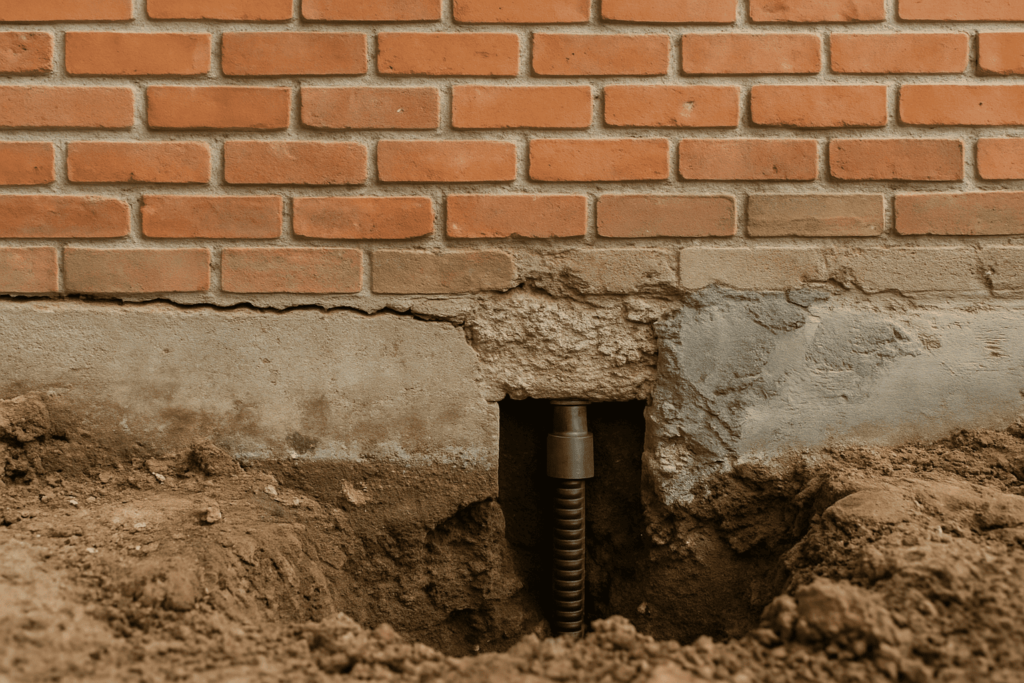A strong and stable Home foundation plays an integral role in providing support to your home and work as a backbone. When the foundation is resilient, everything from the walls to the floors feels safe and puts your mind at peace for an easy living. But every foundation needs to be maintained because even the strongest foundations start cracking and deteriorating over time. Ignoring foundation problems can lead to serious consequences like uneven floors, sticking doors, wall cracks, or even structural failure. Foundations can be repaired easily if they’re promptly addressed, so it’s better to repair them on time before your foundation faces challenges like soil settling and ineffective water runoff.
In this blog, we’ll look into the complexities of foundation settling, how these problem occurs, and how we can repair foundations:
Warning Signs Of Trouble In Foundation
Here are the red flags that indicate that foundation repairs are necessary, and this is alarming for your building:
- Wall Fractures: splits in the foundations that result in structural movement.
- Jammed Openings: If frames don’t align properly, the foundation may be shifting.
- Sagging surfaces: Sagging floors are often caused by settling foundations.
- Structural gaps: Visible separations suggest structural instability.
- Dampness issues: This can weaken concrete and worsen foundation damage.
Moisture problems in masonry are discussed in detail in why is brick pointing critical for protecting bronx structures from water damage?

What Leads to Foundation Problems?
Make sure to know the real cause of foundation damage, to prevent your basements from further damage:
- Earth Displacement: shrinking & swelling of soil.
- Improper Grading: stagnant water undermines the foundation.
- Root Pressure Damage: roots absorb water in excessive amounts.
- Weak Foundation Setup: inappropriate materials used with unprofessional workmanship.
- Seismic Impact: subsurface movement & earth tremors.
If your property is historic, you may also find is brick repointing structural? useful, as it explains how pointing supports stability.
Foundation Repair Techniques
Let’s have a look at some of the most common foundation repair techniques:
Pressure Grouting
- Ideal for uneven concrete flooring.
- Not always lasting due to frequent soil changes
- Speedy & economical.
Driven Steel Piles
- Steel piers or concrete piers are driven deep into stable soil beneath the foundation.
- The foundation is lifted and stabilized using hydraulic jacks.
- Long-lasting solution for significant settlement problems.
Reinforcement Anchors
- Used when basement walls bow or lean inward.
- Steel anchors are placed in the soil outside, connected to plates inside the basement, and tightened to straighten walls.

Structural Fiber Support
- Best for minor cracks or bowing walls.
- Strong carbon fiber strips are applied to walls to prevent further movement.
Water Control Solutions
- Full structural repair solutions for foundation stability.
- Installation of French drains, sump pumps, or waterproof coatings to protect your foundations from water-infestation & drainage issues.
Similar preventive methods are also highlighted in how does NYC’s freeze-thaw cycle impact brick pointing durability?, where moisture management is key.
Final Thoughts
In the end, neglecting the foundation repairs can lead to enormous structural issues, which result in hefty future repair costs. These problems shouldn’t be overlooked, and homeowners should take rapid action to repair home foundations before they get worse. Make sure to hire a professional for durability and strong foundation repairs.
Sardar Restoration Corp. proudly serves every corner of NYC, including the Bronx, Manhattan, Brooklyn, Westchester, and Queens. Our services are designed to meet your needs, providing top-quality solutions wherever you are. Check our service areas to see how we can assist you in your location.
Contact us today at (+1) 917-355-8556 or sardarrestoration@gmail.com, or visit us at 2770 Fish Ave, Bronx, NY 10469, United States.
FAQs
Do you repair foundation cracks in both basements and slabs?
Yes! Sardar Restoration Corp. masterfully repairs both basement foundation and concrete slab, using professional-grade epoxy or polyurethane injections to restore strength and prevent leaks.
Do you offer waterproofing with foundation repair?
Yes! Sardar Restoration Corp. performs waterproofing, using French drains and sump pumps, when repairing the foundation. Our waterproofing services help protect your foundations from further damage.
How long does foundation repair take?
Sardar Restoration Corp. completes most of the foundation repair projects in 2-5 days, but it can also take more, depending on the soil and project conditions.
Do you handle both residential and commercial foundations?
Yes! Sardar Restoration Corp. handles both residential and commercial foundation repairing projects within NYC and its five boroughs, ensuring to maintain a strong yet durable foundation and basements.








